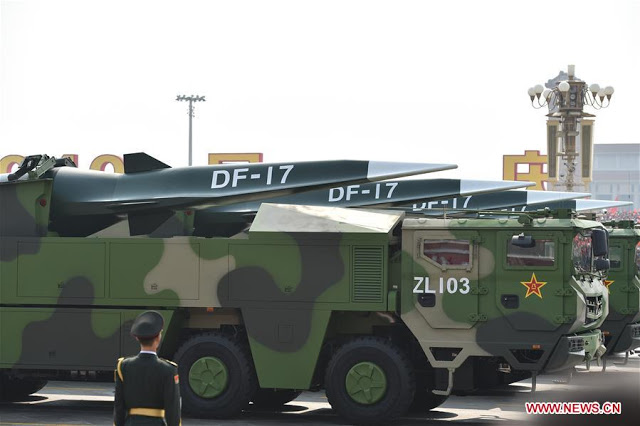
DF-17 with DF-ZF
Nearly 15,000 military personnel, more than 160 aircraft, 580 pieces of weaponry and equipment were paraded in the Tiananmen Square in Beijing to mark the celebrations on the 70th anniversary of Communist China. The message was that China is a fully a developed state with an advanced military capability designed to challenge US strategic primacy. The PLA modernisation process began in the early 1990s, and China is moving with determination towards her goal of becoming a world-class military by 2035.
Addressing the event at Tiananmen Square on October 01, 2019, President Xi said, “No force can shake the foundation of this great nation. Today, socialist China is standing in front the world.” Xi further stated that China’s military would resolutely safeguard the nation’s sovereignty, security and development interests, and firmly uphold world peace. In other words, he actually meant that China today was in a position to challenge the might and strategic supremacy of the US. And, she would not falter in protecting her geo-economic interests anywhere in the world. In fact, he was giving a clear and a loud warning to all her adversaries – all the way from Taiwan to the littorals of the South China Sea to the watershed of McMahon line in India’s North East.
Nearly 15,000 military personnel, more than 160 aircraft, 580 pieces of weaponry and equipment were paraded in the Tiananmen Square in Beijing to mark the celebrations on the 70th anniversary of Communist China. The message was that China is a fully a developed state with an advanced military capability designed to challenge US strategic primacy. The PLA modernisation process began in the early 1990s, and China is moving with determination towards her goal of becoming a world-class military by 2035.
The Chinese also displayed the DF-41 Inter-Continental Ballistic Missile (ICBM), the most powerful ICBM in the world…
For a country like India, this parade should be a wake-up call for its defence planners. Some of the systems on display by China are game changers and futuristic in modern warfare. From China’s strategy of the nineties of “Local Wars under High-Technology Conditions” to 2014 guidelines of “informatisation and integrated joint operations”, they have come a long way, in 2019 they talk of “System of Systems” and “System Destruction Warfare”. They appear to have bridged that gap and these concepts are not just capabilities on paper; they are real. China displayed all of that through this parade and thus conveyed this message to the world from Tiananmen.
The equipment on display highlighted the Chinese military’s capacity to employ “integrated combat forces” to prevail in system-vs-system operations featuring, speed, stealth, information dominance, long-range, precision and joint operations.” This is the modern type of a Maoist statement on “military strategic guideline of active defence”. The most significant capability showcased was the DF-17 Hypersonic Glide Vehicle (HGV) which delivers a warhead at speeds greater than five times the speed of sound (faster than 3,800 mph). China has lead over the United States in hypersonic weapons.
The DF-17 HGV armed with either a nuclear or conventional warhead, could pose a serious threat to the US and her allies operating in the Indo-Pacific region. Owing to its hypersonic speed, no defence against this weapon exists, making US aircraft carrier battle groups in the Asia-Pacific highly vulnerable. The DF-ZF will bring a hypersonic capability to the PLARF. Missiles carrying the DF-ZF will have shorter flight times and be capable of performing evasive manoeuvers at hypersonic speeds, which will complicate the ability of current missile defences to intercept it. The current missiles believed to be capable of carrying the HGV are short and medium-range; but could strike targets in South Korea and Japan as well as US carriers and bases in the region. It is also capable of carrying nuclear payloads as well as conventional weapons.
The Chinese also displayed the DF-41 Inter-Continental Ballistic Missile (ICBM) which has entered operational service. It is the most powerful ICBM in the world, is road-mobile and is able to carry up to ten nuclear warheads. It has overtaken the Russian SS-18 Satan ICBM in capability. The US has nothing comparable, at least in terms of ground-launched ICBMs. This adds a layer to China’s strategic survival and surprise. The DF-41 intercontinental-range ballistic missile, touted to be the most powerful missile on the planet was on display at the National Day parade in Beijing.
The DF-41 has a range of up to 9,320 miles (15,000 kilometres), more than any missile on the Earth. The missile is capable of carrying ten independently targeted nuclear warheads and can, theoretically, hit the US in 30 minutes, as per the experts. Another game changer on display was the Gongji-11 stealth attack drone, capable of attacking strategic targets without being detected. They pose a serious challenge to India’s strategic assets and deterrence in place in her North Eastern Region. China claims that this is vital for the defence of her large territories. The Chinese military commitment to unmanned ‘drone’ aircraft is such that a vast local investment has made possible a slew of modern, over battlefield offerings ranging from small and portable to large and wholly autonomous drones. This new Gongji-11 Unmanned Combat Air Vehicle (UCAV) attempts to significantly broaden Chinese unmanned capabilities and appears largely influenced by Western designs – namely the American Northrop Grumman X-47B technology demonstrator – in shape and overall size.
For India, it points to the urgency to speed up its capacity and capability building through indigenisation and rapid China-centric modernisation of her armed forces…
While little is concretely known of the GJ-11’s capabilities, it is assumed that the air vehicle shares some qualities with its global counterparts of same size and role. It is intended as an attack aircraft so an internal weapons bay is included as part of the aircraft’s makeup. Another notable trait is the design’s inherent stealth characteristics, namely its low profile and shrouded exhaust port. In this manner, the aircraft is expected to ‘sneak’ into enemy airspaces and attack targets of strategic value undetected. The aircraft carries an appearance not unlike the X-47B, being of an all-wing planform (no tail fins are featured whatsoever) with the single internal, air-breathing turbofan engine aspirated by a dorsally-mounted intake just aft and above the nose. The engine exhausts through a low-profile port at the rear of the fuselage also seated dorsally. The wings are well-blended into the fuselage, promoting a smooth overall contour. The overall shape of the aircraft is that of an arrowhead, maximizing aerodynamic and fuel efficiency for useful operational ranges. A retractable tricycle landing gear arrangement is featured for general ground-running exercises. An autonomous capability for this new UCAV is assumed.
China also showed a supersonic reconnaissance drone, called the DR-8, designed to work with the PLA Rocket Force, Navy and Air Force to dash in at high supersonic speed, locate a US carrier battlegroup, and pass information onto strike forces, such as the DF-17, the Sharp Sword and other systems. China’s military is rapidly developing unmanned aircraft and recently disclosed one of its newest systems – a supersonic reconnaissance drone designed to defeat air and missile defences. Military analysts say the DR-8, which is now unveiled and deployed with People’s Liberation Army forces, is a key element needed for targeting and guiding China’s large missile force, especially its DF-21 anti-ship ballistic missile. The drone would function as a critical sensor platform to identify the locations of US aircraft carriers and then provide signals used by Precision Guided Missiles. China has been developing such arms as part of what the Pentagon calls “anti-access/area denial” weapons.
China has raised regional tensions by attempting to take control of both the South China Sea and the East China Sea. Any conflict with China is likely to involve the dispatch of multiple aircraft carrier strike groups to those regions and China is working on perfecting missile systems that will be able to attack ships far from its shores. The DR-8 bears a close resemblance to the US D-21 supersonic drone fielded in 1969 and retired in 1971, highlighting China’s ability to obtain US military know-how and apply it to the large-scale build-up of military forces that has been underway for the past three decades. Other military hardware on display included large numbers of tanks and armoured fighting vehicles, China’s J-20 stealth fighter and the new H-6N strategic bomber. An array of YJ-18 supersonic anti-ship cruise missiles and the DF-26 anti-ship ballistic missile systems of intermediate range were displayed. Equipment displaying advanced information and electronic warfare capabilities were featured as well.
The YJ-18, in particular, stands out among modern cruise missiles carried by destroyers for its combination of a long range and a high impact speed – with 540 km range allowing it to neutralise most hostile destroyer types well beyond retaliation range. The American Arleigh Burke Class, for example, is currently restricted to using Mach 0.7 speed 124 km range anti-ship Harpoon missiles – with the new Harpoon Block III offered by Boeing but yet to be integrated retaining a 310 km range – 43 percent lower than that of the YJ-18. The missile is also over four times faster than the Harpoon upon impact, accelerating to Mach 3 in its terminal phase. This speed makes the missile extremely difficult to intercept, and is sufficient to tear most warships in half with a single direct hit. This damage is supplemented by a 300-kg warhead.
Type 052D was also the first to deploy the YJ-18 and YJ-100 anti-ship cruise missiles, making it one of the best suited warships for ship to ship combat in the world. The Type 052D can theoretically carry up to 64 of these missiles, allowing a single destroyer to potentially destroy an entire fleet at stand-off range. The Type 052D deploys 88 vertical launch cells, 24 of which are reserved exclusively for HHQ-10 surface-to-air missiles with the remaining 64 capable of deploying a variety of air defence, anti-ship and anti-submarine munitions. Complementing the capabilities of the HHQ-10, the HHQ-9 are HQ-16 and quad packed DK-10A surface-to-air missiles can all be deployed from the destroyer’s other cells providing a highly sophisticated multi-layered air defence network. This is further supplemented by the H/PJ-12 close in weapons system. Perhaps the Type 052D’s most remarkable feature, however, is its access to highly sophisticated YJ-18 and YJ-100 anti ship cruise missiles which allow it to neutralise enemy warships at extreme ranges.
The systems on show today beyond doubt highlighted that China is developing Anti-Access and Area Denial (A2/AD) capabilities to deny the US and its allies the ability to project military power and intervene in a regional crisis anywhere in the Indo-Pacific theatre. Advanced supersonic drones, hypersonic glide vehicles, sophisticated air combat capability and missile systems are designed with this role in mind. These advancements pose a serious threat to the regional stability and also present a grave challenge to regional powers like India who had stood up to the Chinese hegemony during the Doklam stand-off in 2017. A large Chinese naval presence in the Indian Ocean and India’s ongoing cooperation with navies of US, Australia and Japan in order to counter any threat to free international shipping lanes in the region of South China Sea may come under serious threat from these weapons displayed.
For the US, this implies the need to find a way to defeat Chinese ‘A2AD’ capabilities. And for India, it points to the urgency to speed up its capacity and capability building through indigenisation and rapid China-centric modernisation of her armed forces. The 70th anniversary parade at Tiananmen was a warning to the US and all the neighbouring states with disputes with China, states such as Japan, Taiwan, South Korea, Vietnam and India. For all of them, the writing on the wall is clear – ignoring China’s leap will be at their own peril.





